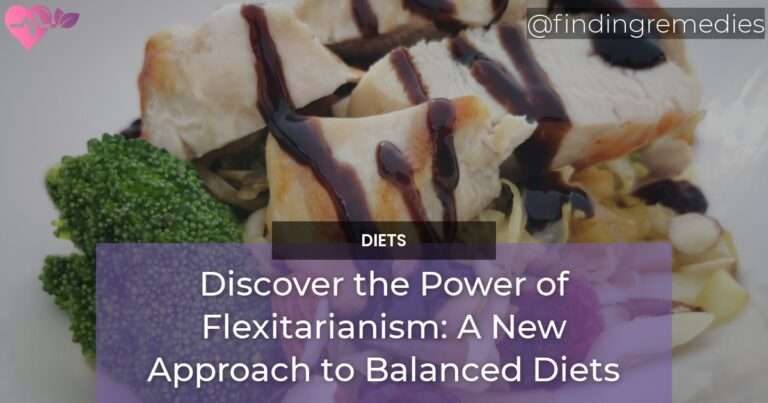The idea of reducing meat intake or eliminating it altogether has been around for quite some time. Vegetarianism and veganism are not new concepts, but the idea of a flexitarian diet is relatively new. Flexitarianism is a semi-vegetarian approach to healthy eating that promotes the reduction of meat intake while still allowing for some meat consumption in moderation.
This article will explore the key components of the flexitarian diet, its health benefits, scientific evidence supporting it, tips for success, risks, and precautions to consider, sustainability, and a sample meal plan to help readers understand the concept of the flexitarian diet better.
Table of Contents
What is a Flexitarian Diet?
A flexitarian diet is a mostly plant-based diet that includes small amounts of meat, dairy, and other animal products. Flexitarians typically eat more fruits, vegetables, whole grains, legumes, and nuts than meat-eaters but are not limited to vegetarian or vegan alternatives. The goal is to reduce meat consumption while still enjoying the occasional meat-based meal. It’s a flexible and sustainable approach to healthy eating that emphasizes nutrient-dense plant-based foods.
Health Benefits of a Flexitarian Diet
A flexitarian diet has numerous health benefits, including:
Reduced Risk of Chronic Diseases
Studies have found that reducing meat intake and increasing plant-based food consumption can help lower the risk of chronic diseases such as heart disease, type 2 diabetes, and certain types of cancer.
Weight Management
Flexitarianism can help with weight management by promoting the consumption of nutrient-dense, low-calorie plant-based foods. Plant-based foods are typically lower in calories and more filling than meat and dairy products.
Improved Nutrient Intake
A flexitarian diet can lead to an increased intake of essential nutrients such as fiber, vitamins, and minerals. Plant-based foods are rich in these nutrients and can improve overall health and wellbeing.
Scientific Evidence Supporting a Flexitarian Diet
There is a growing body of scientific evidence supporting the health benefits of a plant-based diet. Studies have shown that a plant-based diet can help reduce the risk of chronic diseases, improve cardiovascular health, and promote a healthy weight. In comparison to other dietary patterns, flexitarian diets have been found to be more sustainable and healthier.
Tips for Success on a Flexitarian Diet
Here are some tips to help individuals succeed on a flexitarian diet:
Incorporating More Plant-Based Foods
- Focus on increasing the intake of fruits and vegetables, whole grains, legumes, and nuts.
- Use herbs and spices to flavor plant-based dishes.
- Experiment with different recipes and cuisines to keep meals interesting and varied.
Meal Planning and Preparation
- Plan meals ahead of time to ensure adequate nutrient intake.
- Batch cook and freeze meals for busy days.
- Make use of leftovers for quick and easy meals.
Finding Alternatives for Meat-Based Dishes
- Experiment with vegetarian and vegan alternatives to meat-based dishes.
- Use plant-based proteins like tofu, tempeh, and legumes to replace meat in dishes.
- Try meatless versions of favorite dishes like lasagna, chili, and burgers.
Risks and Precautions to Consider
While a flexitarian diet can be healthy, there are some risks and precautions to consider:
Ensuring Adequate Nutrient Intake
Flexitarians need to make sure they are getting enough protein, iron, calcium, and vitamin B12. They can get these nutrients from plant-based foods like legumes, nuts, seeds, and whole grains or through supplements if needed.
Monitoring Protein Intake
Meat is a source of high-quality protein, so reducing meat consumption requires finding other sources of protein. Plant-based proteins like beans, nuts, and tofu can be used as substitutes.
Avoiding Heavily Processed Vegetarian Options
Processed vegetarian alternatives to meat can be high in sodium, fat, and calories. Flexitarians should choose whole food options that are minimally processed for optimal health benefits.
Flexitarianism and Sustainability
The flexitarian diet is a sustainable approach to healthy eating that considers the environmental impact of food choices. Meat production is resource-intensive and has a significant carbon footprint. Reducing meat consumption can help reduce greenhouse gas emissions and contribute to a more sustainable food system. Flexitarianism promotes ethical eating and sustainable living.
Flexitarian Diet in Practice: Sample Meal Plan
Here’s an example of a day’s worth of meals and snacks for a flexitarian diet:
- Breakfast: Overnight oats made with almond milk, chia seeds, and fruit.
- Snack: Apple slices with almond butter.
- Lunch: Chickpea salad with mixed greens, tomatoes, and cucumber.
- Snack: Hummus with carrot sticks.
- Dinner: Spaghetti squash with marinara sauce and meatless meatballs.
- Snack: Mixed berries with Greek yogurt.
Conclusion
The flexitarian diet is a flexible and sustainable approach to healthy eating that offers numerous health benefits supported by scientific evidence. The diet emphasizes plant-based foods, reducing meat consumption, and promoting the use of whole foods for optimal health benefits. By incorporating more plant-based foods and reducing meat intake, individuals can improve their nutrient intake, manage their weight, and contribute to a more sustainable food system.

